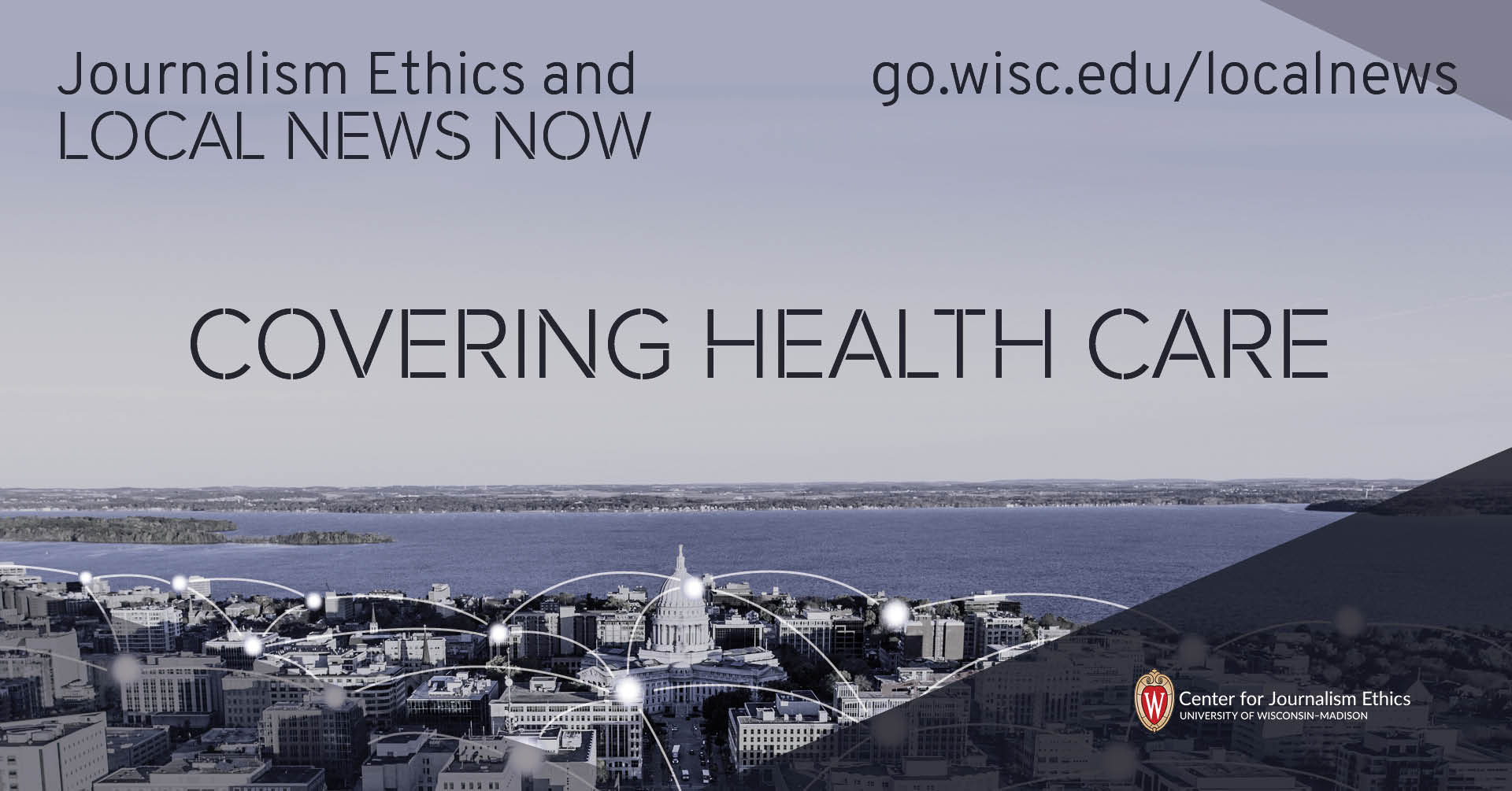
By Jack Kelly and Howard Hardee
Health care is critical issue that touches every person in the United States regularly. It also happens to be among the most complicated issues encountered by both everyday people and journalists. What’s the difference between Medicaid and Medicare? Why are prescription drug prices so high? What is open enrollment in the Affordable Care Act marketplace? How has COVID-19 changed trips to the doctor’s office? Let’s tackle health care from a local perspective.
HEALTH CARE STORIES ARE local
The COVID-19 pandemic has shown that telemedicine appointments are here to stay. But for some people, that’s easier said than done. Many folks in rural America lack access to broadband, while countless people living in cities can’t afford the cost of high-speed internet. So, whether you cover a collection of rural counties or a single neighborhood in a big city, broadband access has become a barrier to health care.

Sources
- Federal Communications Commission map of broadband access by county.
- 2020 FCC state-by-state, county-by-county report on access to broadband (shows number of people living without broadband access in each state).
- A 2020 study from the Centers for Disease Control and Prevention showing an explosion in telehealth appointments in response to the COVID-19 pandemic.
- Steve Kelley, former fellow at the Humphrey School of Public Affairs and expert on rural broadband; Email: kelle644@umn.edu, Tel: 612-626-6629.
- Consider consulting local officials about issues constituents face because of lack of reliable internet access.
In mid-March, the Biden administration extended the open-enrollment period for health care plans under the Affordable Care Act (ACA) until Aug. 15. The extension is aimed at giving people additional time to sign up or reconsider their coverage in light of increased subsidies included in the American Rescue Plan. ACA was hampered under the Trump administration, and Biden’s new policies will likely lead to increases in enrollment. This is a prime opportunity for reporters to localize a federal program, showing via human interest or hard news the importance of affordable health care – especially in a post-pandemic world.

Sources
- Centers for Medicaid and Medicare services announced in January that 8.3 million people enrolled in plans through HealthCare.gov in the previous enrollment period. That includes tens of thousands of people in all 50 states, and will likely grow with the Biden extension.
- Centers for Medicare and Medicaid Services official Medicaid enrollment data by state.
- Laura Packard, advocate and executive director of Get America Covered, expert on ACA enrollment; Email: laura@laurapackard.com.
COVID-19 had a devastating – and deadly – impact on residents of America’s nursing homes. Crowded living conditions, paired with the vulnerability of patients, made long-term care facilities especially prone to coronavirus outbreaks. But since the rollout of safe and effective COVID-19 vaccines, deaths among nursing home residents have decreased sharply. So, what’s next for nursing homes? This story is a great opportunity to draw a connection between big-picture data and local communities’ elderly, as well as to examine how nursing homes are starting to prepare for the next public health emergency.

Sources
- This New York Times’ database tracks the number of COVID-19 deaths in nursing homes nationwide. The database also allows users to search by facility name.
- Who owns the facilities in your area and what is their Medicare rating? You can find out at this Medicare site.
- This ProPublica database allows you to track “incidents” at nursing homes across the country.
- Your local AARP office or other elderly advocacy groups.
The coronavirus crisis has been a pandemic on multiple fronts. Beyond the extremely visible, tragic rush of COVID-19 patients at hospitals and the hundreds of thousands of deaths caused by the virus, the last year has triggered a mental health crisis across the United States. A Kaiser Family Foundation poll found that roughly 40% of American adults “reported symptoms of anxiety or depressive disorder” in the past year, up from 10% of American adults in 2019. The effects of the pandemic on mental health could be long-lasting. This angle provides an opportunity to evaluate local health systems’ readiness to provide mental health care, as well as to hear from “real” people about their mental health journeys during the pandemic.

Sources
- State-by-state breakdown of Kaiser Family Foundation poll examining mental health during the pandemic. Allows users to select data to show trend lines based on KFF tracking polls over time.
- Resource guide from Mental Health America, a national mental health advocacy nonprofit, focused on wellness and coping skills for people struggling with their mental health during the pandemic.
- Dr. Jessi Gold, associate professor of psychiatry, Washington University School of Medicine; Email: jgold@wustl.edu, Tel: 314-286-1700.
- Consult local city or county health departments to learn more local demand and available resources. This is especially pertinent in rural areas.
- Explore the “circle of grief” caused by pandemic deaths by interviewing those who lost a loved one to COVID-19.
Throughout the pandemic, the toll on the wellbeing of overworked, traumatized health care workers has been immense. What are the long-term ramifications of a mass casualty event that resulted in extreme workloads and overflowing hospital wards? Are nurses and doctors getting the support and mental health treatment they need? Will the pandemic lead to an exodus from the profession? If healthcare professionals do walk away, what will that mean for their communities?

Sources
- Survey from Mental Health America showing that 93% of health care workers experienced stress during the COVID-19 pandemic. (Survey contains other info)
- 2020 Medscape report on physician mental health and burnout.
- Brittany Neal, emergency department nurse and advocate, can speak to understaffing issues nurses experience and stress in hospital settings, contact using this form.
INTERVIEW W/ POPULATION HEALTH EXPERT TIFFANY GREEN
INTERVIEW W/ HEALTH CARE REPORTER BRAM SABLE-SMITH

Bram Sable-Smith
Bram Sable-Smith, a health care reporter for Wisconsin Public Radio embedded in the newsroom of the Wisconsin Center for Investigative Journalism, talked with the Center for Journalism Ethics about covering health care at the local level. Here are a few of his insights:
While reporting health care stories, you often come across sources that aren’t used to speaking with journalists. What have you learned about conducting these interviews that would be useful to local reporters who don’t cover health care everyday?
I think it’s really good to re-examine our relationships with sources. Politicians and public figures are one thing, but when you’re reporting on people who are in really vulnerable positions, it’s good that we’re examining that relationship, understanding that, to an extent, what we do is extractive and can’t be helped.
You need to be cognizant of letting these people know how you’re going to use this information. You want to be straightforward with people: ‘You’re telling me this, this is what I’m going to say. … I’m going to publish this story and say you have this condition, this vulnerability. It might go in a newspaper. It might go online. People are going to be able to see this and associate your name with this thing you’re telling me, and I want you to understand that.
I always have to tell people, ‘Before we get started on our interview, I’m going to record this. I may use it in a radio story. I also work for Wisconsin Watch and I could potentially put this in a web story, and those web stories get picked up by newspapers and other outlets, so it could potentially appear in a lot of places. I don’t want you to be surprised if [a television station] picks this up.
How do you decide what personal details to include when sharing someone’s story?
With health care in particular, the personal details are interesting and compelling and really draw people in, but to a certain extent they’re kind of besides the point. If there are people up against the system — people being sued over medical debt because they have a high deductible health plan that they didn’t understand — their personal details are interesting and compelling because it shows the people behind what’s happening. But it’s kind of secondary to the larger trend that’s happening, the bigger implications, the bigger patterns and inequalities; unfair structures. Those are the real things we’re trying to examine by reporting on health care. … The bigger issue is not the person, it’s the structures they’re up against.
What else should local reporters keep in mind if they’re assigned one of these stories?
People are taking these furlough days, which require them to be more collaborative. You’re working on this story, it needs to get out, but you can’t work tomorrow because you’re furloughed, so it’s important to respect the work share program you established. That requires giving up a certain amount of ownership in your stories, it means sharing bylines. There’s a recognition that getting the story out is more important than who gets credit. I think that’s a healthy lesson, not just because it saves jobs but it’s an important lesson for journalism.
The Center for Journalism Ethics encourages the highest standards in journalism ethics worldwide. We foster vigorous debate about ethical practices in journalism and provide a resource for producers, consumers and students of journalism. Sign up for our quarterly newsletter here.
